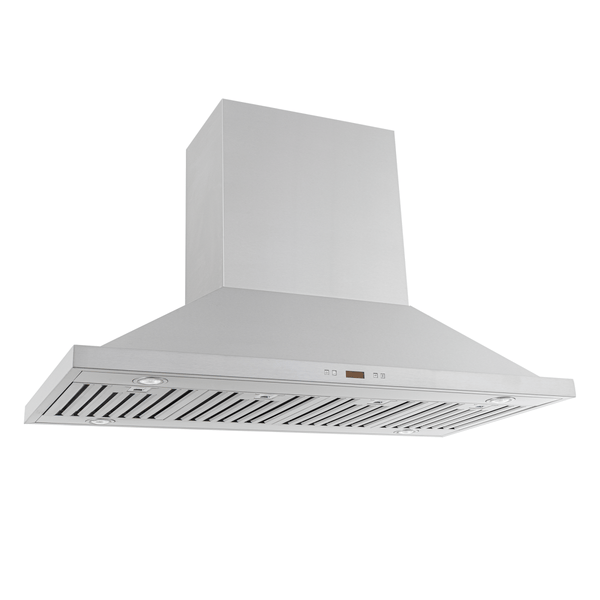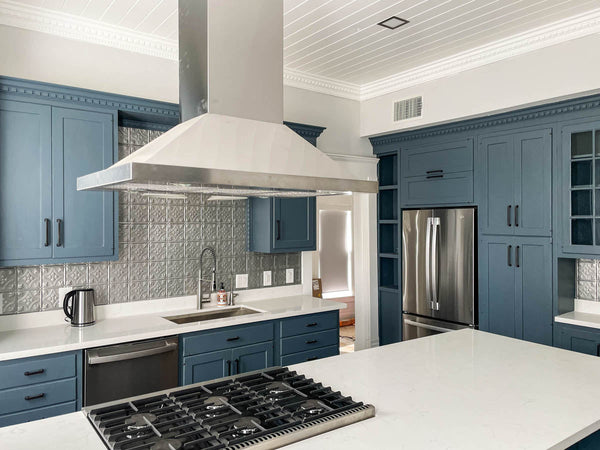Table of Contents
There are several things to keep in mind when installing your outdoor range hood. We want to help you through that process smoothly and keep you from making any crucial mistakes that will cost you time and effort.
Here are some of our best practical tips to consider when installing your outdoor range hood.
Tip 1 Purchase a hood at least 12 inches larger than your range – twice that of an indoor range hood.

Range hood size is especially important with outdoor hoods since grills produce lots of intense heat, smoke, and grease. It is critical that you purchase a range hood that is large enough to cover at least six inches beyond your range on each side. (We suggest 3 inches on each side for an indoor hood)
For example, a 60” outdoor hood will provide nice coverage for your 48” range.
Without a hood that is 12 total inches larger than your range, your outdoor kitchen will become smoky and greasy quickly. Instead of catching all of the cooking exhaust, most of it will sneak past your vent hood and stick to surrounding surfaces.
Tip 2 - Mount it between 36 and 42 inches above your cooktop, further away than an indoor hood.

For the same reason that you need a hood larger than your range, you’ll want to mount it far away from your range as well. 36” and 42” away is the optimal range. Any closer, and heat from your grill may damage your hood. Any further away, and most of the cooking exhaust and grease will escape into your cooking space, instead of venting into your hood and in another area outside your home.
Tip 3 - Use an appropriately sized duct, which varies based on the CFM of your hood.
With an outdoor range hood over a grill – or sometimes two grills – a lot of air will be moving through the ductwork. Make sure that your ductwork is large enough to let all this air move through smoothly. With small ductwork, you will choke the air inside the vent. Then, grease and pressure will build up which will reduce the life of your hood and can cause issues in the long run.
Here’s a duct sizing chart to help you with your installation. For outdoor range hoods, especially the ones rated at 2000 CFM, the safe bet is to go with at least 10” duct.

Tip 4 - Double check that you have the room to run ductwork outside of your cooking space.

For indoor and outdoor range hoods alike, it’s important to ensure that you have enough room to install ductwork.
But, for outdoor range hoods, this is even more important.
For example, if you don’t have the room to duct to the outside with your indoor hood, you can always purchase one that is ductless.
But, we do not recommend purchasing a ductless outdoor hood. Since you’ll be cooking over a grill, it’ll produce a lot of smoke and you want to vent that elsewhere to ensure your health and safety. A ducted hood is needed to protect your outdoor cooking space and eliminate strong cooking odors.
Tip 5 - Use Rigid Ductwork

We’ve talked a lot about the amount of cooking exhaust that your grill will produce – and with this tip, it’s again important. Rigid ductwork is definitely the way to go because it is much more durable and moves air better than flexible ductwork. Flex ducting simply won’t last long and it may require replacement after a short period of time.
Installing an outdoor range hood will be quite similar to, but not exactly the same as installing an indoor range hood. Use some of our videos below for reference as you progress through your installation.
How to Install a Wall Mount Range Hood
How to Install a Recirculating Range Hood
How to Install an Island Range Hood
If you have any questions about your outdoor hood installation, don’t hesitate to contact us at (877) 901-5530. But, we recommend consulting a professional as well since every installation is slightly different.
What Height Should I Mount My BBQ Range Hood?
For outdoor BBQ range hoods, the ideal mounting height is between 36 and 42 inches above the cooking surface. This height range is recommended for several key reasons:
Heat Clearance: Outdoor grills generate significantly more intense heat compared to indoor cooktops. Mounting the range hood too close, under 36 inches, could potentially cause heat damage to the hood over time, compromising its integrity and lifespan.
Effective Smoke and Odor Capture: The 36-42 inch range allows the hood to effectively capture smoke, grease, and cooking odors rising from the grill. Any higher than 42 inches, and the hood's capture area becomes less effective at pulling in the exhaust, leading to lingering smoke and odors in your outdoor living space.
Accounting for Outdoor Cooking Conditions: The extra distance compared to indoor range hoods (typically mounted 28-36 inches high) accounts for the greater heat output, exhaust production, and air movement outdoors where wind can interfere with ventilation.
The installation process depends on the design of your kitchen, the type of hood you’re installing (wall, island), the surface that you are mounting your hood to (brick, sheetrock, etc.), where you can run your ductwork, the length of your ductwork, and many other factors.
Outdoor Range Hood Maintenance
Keeping your outdoor range hood in top shape isn't too complicated but does require regular upkeep. Start with the exterior: every 4-6 weeks, wipe it down with a damp cloth and mild soap or a vinegar solution to prevent grease buildup. For tougher grime, you might need a degreasing soap or baking soda paste. Scrub gently with a soft-bristle brush, then rinse thoroughly and dry completely to avoid water spots and corrosion.
Moving on to the filters, they need regular attention too. Clean them every 2-3 months to keep your range hood functioning efficiently. Baffle filters can usually be cleaned in the dishwasher. For mesh or stainless steel filters, soaking them in hot water and degreaser works well. After soaking, scrub with a soft brush, rinse thoroughly, and let them dry completely before reinstalling.
When it comes to the interior, always turn off the power and unplug the range hood before you start cleaning. Use a degreasing solution and a soft brush to clean the fan blades, being careful around the electrical parts. It's also important to clean out any grease buildup in the interior housing with a degreaser.
Don't forget about the ductwork. Clean it annually to remove accumulated grease and debris. You can use a duct cleaning brush or hire a professional duct cleaning service for a thorough job.
Additionally, check the lights and replace bulbs as needed. Inspect and clean the motor housing area to prevent overheating, and lubricate any moving parts like fan motors according to the manufacturer’s instructions.
Regular deep cleaning at least twice a year, especially before and after peak outdoor cooking seasons, is recommended to maintain efficiency and prevent potential fire hazards from grease buildup.
Determining the Right CFM
We have a great article over here that quickly explains how to determine the right CFM for your outdoor hood. Click here to check it out.Can I Use an Indoor Hood for an Outdoor Kitchen?
No, you should not use an existing indoor range hood for an outdoor kitchen. Indoor range hoods are designed for enclosed indoor spaces and do not provide adequate ventilation for outdoor cooking areas.
Here are a few key reasons why you need a dedicated outdoor range hood:
- Outdoor cooking produces significantly more smoke, grease, and odors compared to indoor cooking. An indoor hood lacks the power and capacity to effectively capture and vent these emissions in an open-air environment.
- Outdoor hoods are constructed from weather-resistant materials like stainless steel to withstand outdoor elements like rain, humidity, and temperature fluctuations that indoor hoods cannot handle.
- Outdoor hoods have much higher CFM (cubic feet per minute) ratings, typically 1200 CFM or higher, to provide the powerful suction needed to ventilate an open-air cooking area effectively.
- Outdoor hoods extend much deeper (32 inches or more) to maximize capture area over large outdoor grills and cooking equipment compared to indoor hoods designed for standard residential ranges.
If you’d like more information, take a look at more of our articles on outdoor range hoods below.
Related Articles
Why do I need an outdoor range hood?
Don’t Install Your Range Hood Until You Read This Ultimate Guide!
4 Best Outdoor Vent Hoods from Proline
9 Benefits of Proline's Outdoor Range Hoods
Check out our BBQ Range Hoods:
Learn More










